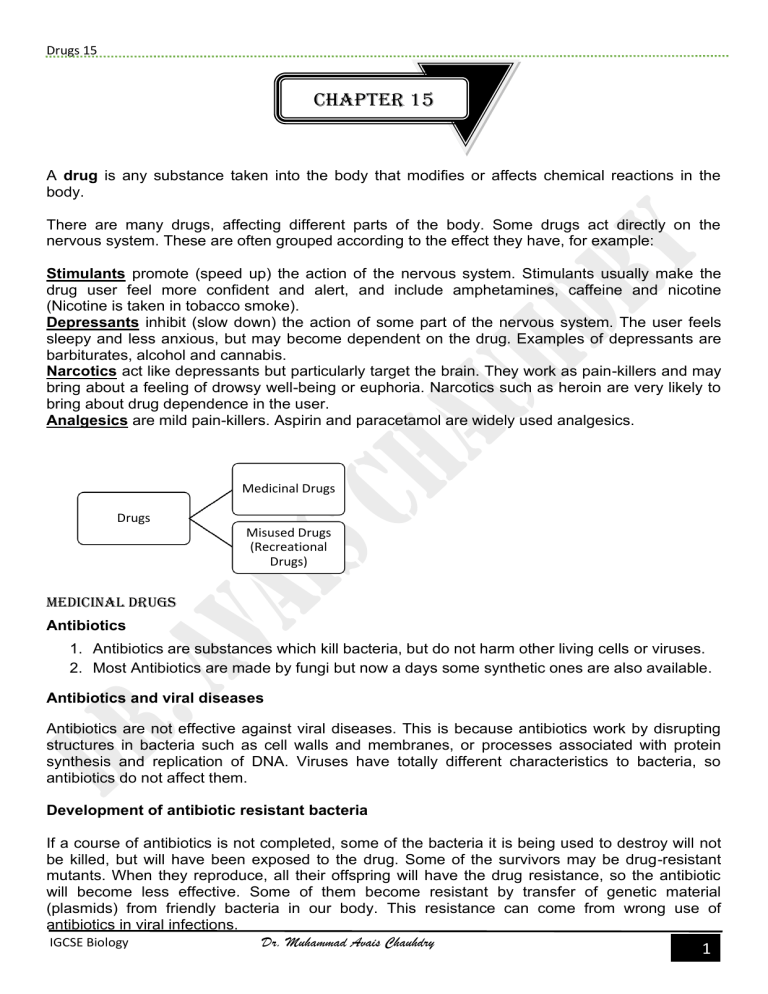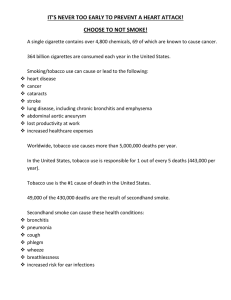
Drugs 15 CHAPTER 15 A drug is any substance taken into the body that modifies or affects chemical reactions in the body. There are many drugs, affecting different parts of the body. Some drugs act directly on the nervous system. These are often grouped according to the effect they have, for example: Stimulants promote (speed up) the action of the nervous system. Stimulants usually make the drug user feel more confident and alert, and include amphetamines, caffeine and nicotine (Nicotine is taken in tobacco smoke). Depressants inhibit (slow down) the action of some part of the nervous system. The user feels sleepy and less anxious, but may become dependent on the drug. Examples of depressants are barbiturates, alcohol and cannabis. Narcotics act like depressants but particularly target the brain. They work as pain-killers and may bring about a feeling of drowsy well-being or euphoria. Narcotics such as heroin are very likely to bring about drug dependence in the user. Analgesics are mild pain-killers. Aspirin and paracetamol are widely used analgesics. Medicinal Drugs Drugs Misused Drugs (Recreational Drugs) Medicinal drugs Antibiotics 1. Antibiotics are substances which kill bacteria, but do not harm other living cells or viruses. 2. Most Antibiotics are made by fungi but now a days some synthetic ones are also available. Antibiotics and viral diseases Antibiotics are not effective against viral diseases. This is because antibiotics work by disrupting structures in bacteria such as cell walls and membranes, or processes associated with protein synthesis and replication of DNA. Viruses have totally different characteristics to bacteria, so antibiotics do not affect them. Development of antibiotic resistant bacteria If a course of antibiotics is not completed, some of the bacteria it is being used to destroy will not be killed, but will have been exposed to the drug. Some of the survivors may be drug-resistant mutants. When they reproduce, all their offspring will have the drug resistance, so the antibiotic will become less effective. Some of them become resistant by transfer of genetic material (plasmids) from friendly bacteria in our body. This resistance can come from wrong use of antibiotics in viral infections. IGCSE Biology Dr. Muhammad Avais Chauhdry 1 Drugs 15 Misused drugs Heroin Opium poppies produce a substance called opium. Heroin, morphine and codeine belong to a group of drugs called narcotics, made from opium. Heroin acts a as powerful depressant (slowing down many functions of the brain) it relieves severe pain, slows down breathing and functions of hypothalamus and produce short-lived feelings of wellbeing (euphoria) and freedom from anxiety. It can both lead to tolerance and physical dependence within weeks, so prescribed with caution (a warning against danger), to patients in severe pain. The illegal use of heroin has terrible effects on the unfortunate addict. The overwhelming dependence on the drug leads many addicts into prostitution and crime to obtain the money to buy it. Endorphins Endorphins are neurotransmitters, chemicals that pass along signals from one neuron to the next. Endorphins help to reduce sensations of pain, affect mood and reduce sensations of hunger and thirst. When heroin enters the brain, heroin is metabolized to morphine. Morphine molecule fit into some of the endorphin receptors. Therefore, heroin makes people feel good. Heroin can reduce the production of natural endorphins and affects the brain’s production of other important neurotransmitters. Withdrawal Symptoms of Heroin There are severe withdrawal symptoms when an addict tries to give up the drug abruptly. These symptoms are called going ‘cold turkey’ and can include anxiety, muscle aches, sweating, abdominal cramping, diarrhoea, nausea and vomiting. A ‘cure’ is a long and often unsuccessful process. Additional hazards are that blood poisoning, hepatitis and AIDS may result from the use of unsterilised needles when injecting the drug. IGCSE Biology Dr. Muhammad Avais Chauhdry 2 Drugs 15 Smoking What is in tobacco smoke? Tobacco smoke is a cocktail of up to 4000 different chemicals and is released into the atmosphere in two ways: Mainstream (Active smokers) smoke from the filter or mouth end of the cigarette/cigar/pipe Side stream (Passive smokers) smoke from the burning tip of the cigarette/cigar/pipe tobacco. Around 85% of tobacco smoke in a room will be side stream smoke - the form which contains higher concentrations of many toxins than mainstream smoke. Breathing in this smoke is called passive smoking and presents a health hazard to people nearby who inhale it. Of the thousands of chemicals in tobacco smoke, three important ones are: Carbon monoxide - a poisonous gas also found in car exhaust fumes. It combines with haemoglobin and forms carboxyhaemoglobin in an irreversible reaction, preventing it from transporting respiratory gases. This decreases the overall oxygen carrying capacity of a person. Nicotine - a poisonous alkaloid drug that is addictive. 60mg of nicotine placed on the tongue would kill an individual within minutes. It is absorbed by the body very rapidly, reaching the brain in less than 30 seconds. Addiction – once your body has got used to it, it is very hard to do without it. It is stimulant (makes you more alert and active) raises blood pressure and heart rate, increases cholesterol deposition in arteries. It is also a stimulant which makes the heart beat faster and at the same time makes blood vessels narrow, together these two effects raise blood pressure (causing long-term damage to the circulation). The increased heart rate increases the demand for oxygen, but carbon monoxide reduces oxygen availability - so heart muscle is more likely to be damaged. TAR - a sticky, brown substance responsible for the staining of the fingers and teeth of smokers. It appears in tobacco smoke as minute droplets. It contains 16 carcinogenic substances hence it can cause lung cancer. Irritates the lining of the trachea causing the increased production of mucus hence paralyses the cilia. It can also cause bronchitis. Excessive coughing can breakdown the thin walls of alveoli decreasing the surface area of gaseous exchange and this is called emphysema. Other irritants in tobacco smoke include smoke particles, ammonia and sulfur dioxide. 1. Bronchitis: this is a disease caused by cigarette smoke which paralyses the cilia, as a result filtration of dust particles will not be efficient. Excess mucus can reduce the diameter of the tract and can get into the alveoli. 2. Lung Cancer: Cigarette smoke contains tar which has almost 16 carcinogenic substances. Once the tar gets deposited in the wall of the alveoli, it can cause lung cancer. 3. Emphysema: results when the walls of the air sacs are destroyed. This happens because smoke affects white blood cells which then destroy lung tissue. When the walls break down there is less surface for gas exchange, and breathing becomes very difficult. Somebody with emphysema may only be able to walk 2 or 3 meters before becoming breathless. Emphysema is almost unknown in non-smokers. IGCSE Biology Dr. Muhammad Avais Chauhdry 3 Drugs 15 Alcohol Small amounts give a sense of wellbeing, with a release from anxiety. Alcohol is quickly absorbed through the wall of the stomach, and carried all over the body in the blood. It is eventually broken down by the liver, but this takes quite a long time. Drinking fairly small quantities of alcohol is not dangerous, but alcohol does have many effects on the body which can be very dangerous if care is not taken. Alcohol lengthens reaction time. The alcohol in wines, beer and spirits is a depressant of the central nervous system which means that even small amounts of alcohol slow down the actions of parts of the brain, so alcohol lengthens the time you take to respond to stimuli. Alcohol can increase aggression in some people. Alcohol reduces inhibitions because it depresses that part of the brain which causes shyness. This may be considered an advantage in ‘breaking the ice’ at parties. But it can also lead to irresponsible behavior such as vandalism and aggression. Research has shown that at least 50% of violence in the home in many countries is related to drunkenness, and that alcohol has played a part in the criminal behavior of around 60% of people in prison in western countries. Alcohol has widespread effects throughout the body 1. Cardiovascular effects include anemia (alcohol poisons bone marrow) and increased deposits of fat in the coronary arteries. 2. Skin blood vessels dilate so warm blood flows to the skin. The body feels warm and comfortable, but hypothermia may result at low environmental temperatures. 3. Sex organs are stimulated but do not work well. Sperm count may be reduced. 4. Intestines are irritated, causing indigestion, nausea, diarrhoea and ulcers. 5. In pregnant women, alcohol may cross the placenta to the unborn child. The child may develop addiction slowly, especially its nervous system (this is called fetal alcohol syndrome). 6. Liver cells work harder to detoxify the alcohol. Cells lining blood vessels are damaged causing cirrhosis - liver function begins to fail. 7. Kidneys cannot reabsorb water very well. Too much water is excreted and the body becomes dehydrated (this is responsible for the headache following a drinking bout). 8. Cancer of the tongue and esophagus are much more likely in heavy drinkers (especially if they also smoke). IGCSE Biology Dr. Muhammad Avais Chauhdry 4


